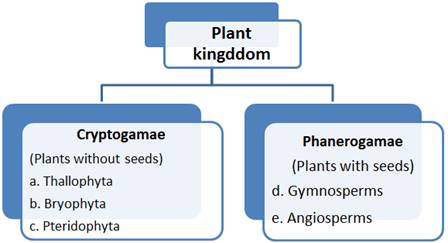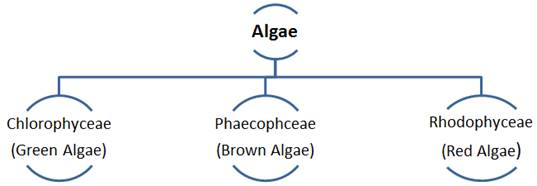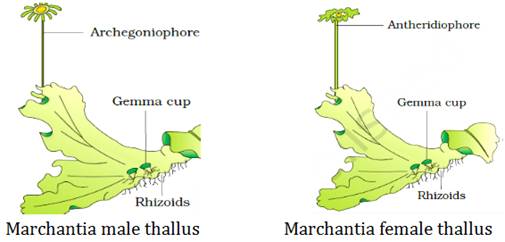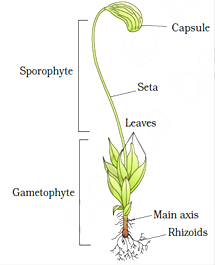
myCBSEguide App
Download the app to get CBSE Sample Papers 2023-24, NCERT Solutions (Revised), Most Important Questions, Previous Year Question Bank, Mock Tests, and Detailed Notes.
Install NowCBSE Biology Chapter 3 Plant Kingdom class 11 Notes Biology in PDF are available for free download in myCBSEguide mobile app. The best app for CBSE students now provides Plant Kingdom class 11 Notes Biology latest chapter wise notes for quick preparation of CBSE exams and school based annual examinations. Class 11 Biology notes on Chapter 3 Plant Kingdom class 11 Notes Biology are also available for download in CBSE Guide website.
CBSE Guide Plant Kingdom class 11 Notes
CBSE guide notes are the comprehensive notes which covers the latest syllabus of CBSE and NCERT. It includes all the topics given in NCERT class 11 Biology text book. Users can download CBSE guide quick revision notes from myCBSEguide mobile app and my CBSE guide website.
Plant Kingdom class 11 Notes Biology
Download CBSE class 11th revision notes for Chapter 3 Plant Kingdom class 11 Notes Biology in PDF format for free. Download revision notes for Plant Kingdom class 11 Notes Biology and score high in exams. These are the Plant Kingdom class 11 Notes Biology prepared by team of expert teachers. The revision notes help you revise the whole chapter in minutes. Revising notes in exam days is on of the best tips recommended by teachers during exam days.
Download Revision Notes as PDF
CBSE Quick Revision Notes
CBSE Class-11 Biology
CHAPTER-03
Plant Kingdom class 11 Notes Biology
- Eukaryotic, multicellular, chlorophyll containing and having cell wall, are grouped under the kingdom Plantae. It is popularly known as plant kingdom.
- Phylogenetic system of classification based on evolutionary relationship is presently used for classifying plants.
- Numerical Taxonomy use computer by assigning code for each character and analyzing the features.
- Cytotaxonomy is based on cytological information like chromosome number, structure and behaviour.
- Chemotaxonomy uses chemical constituents of plants to resolve the confusion.

Algae: These include the simplest plants which possess undifferentiated or thallus like forms, reproductive organs single celled called gametangia. It includes only Algae.
Characteristic of Algae
- Plant body is thallus, which may be unicellular, colonial, filamentous or parenchymatous.
- Usually aquatic but a few are also found in moist terrestrial habitats like tree trunks, wet rocks, moist soil, etc.
- Vascular tissues and mechanical tissues are absent.
- Reproduction is vegetative by fragmentation, asexual by spore formation (zoospores) and sexual reproduction by fusion of two gametes which may be Isogamous (Spirogyra), Anisogamous (Chlamydomonous) or Oogamous (Volvox).
- Life cycle is various- haplontic, diplontic or diplohaplontic.

| Green Algae | Brown Algae | Red Algae |
| Mostly fresh water and sub aerial. | Mostly marine. | Mostly marine. |
| Unicellular organisms abundant. | Unicellular species are absent. | Unicellular species fewer. |
| Chlorophyll a and b type. | Chlorophyll a and c type. | Chlorophyll a and d type. |
| Reserve food is starch | Reserve food is laminarin. | Reserve food is floridean starch. |
| Cell wall is of cellulose. | Cell wall contains cellulose and algin. | Cell wall contains cellulose and poly-sulphate esters. |
| Fucoxanthin is absent | Fucoxanthin present. | Phycoerythrine is present. |
| Zoospores present. | Zoospores present. | Zoospores absent. |
| Chlamydomonas, Ulothrix, spirogyra. | Focus, Sargassum, ectocarpus. | Polysiphonia, Gelidium, Porphyra etc. |
Economic importance-
- A number of brown algae ( Laminaria, Sargassum) are used as food in some countries.
- Fucus and Laminaria are rich source of Iodine.
- Laminaria and Ascophyllum have antibiotic properties.
- Alginic acid is obtained from Fucus and Sargassum, which is used as emulsions.
Bryophytes – They are non-vascular mosses and liverworts that grow in moist shady region. They are called amphibians of plants kingdom because these plants live on soil but dependent on water for sexual reproduction.
Characteristic features-
- Live in damp and shady habitats, found to grow during rainy season on damp soil, rocks, walls, etc.
- The dominant phase or plant body is free living gametophyte.
- Roots are absent but contain rhizoids
- Vegetative reproduction is by fragmentation, tubers, gemmae, buds etc. sex organs are multicellular and jacketed. The male sex organ is called antheridium. They produce biflagellate antherozoids. The female sex organ called archegonium is flask-shaped and produces a single egg.
- Sporophyte is dependent on gametophyte for nourishment.
Bryophytes Hepaticopsida (Liverworts)
- The plant body of a liverwort is thalloid, e.g., Marchantia. The thallus is dorsiventral and closely appressed to the substrate.
- Asexual reproduction in liverworts takes place by fragmentation, or by the formation of specialised structures called gemmae.
- Gemmae are green, multicellular, asexual buds, which develops in small receptacles called gemma cups. The gemmae becomes detached from the parent body and germinate to form new individuals
- During sexual reproduction, male and female sex organs are produced either on the same or on different thalli. The sporophyte is differentiated into a foot, seta and capsule. Spores produced within the capsule germinate to form
free-living gametophytes.
Bryopsida (Mosses)

- The gametophyte of mosses consists of two stages- the first stage is protonema stage, which develops directly from spores. It is creeping, green and frequently filamentous. The second stage is the leafy stage, which develops from secondary protonema as lateral bud having upright, slender axes bearing spirally arranged leaves.
- Vegetative reproduction is by the fragmentation and budding in secondary protonema. In sexual reproduction, the sex organs antheridia and archegonia are produced at the apex of the leafy shoots.
- Sporophytes in mosses are more developed and consist of foot, seta and capsule.
- Common examples are Funaria, Polytrichum, Sphagnum etc.
Pteridophytes

- They are seedless vascular plants that have sporophytic plant body and inconspicuous gametophyte. Sporophytic plant body is differentiated into true stem, roots and leaves.
- Vascular tissue are present but vessels are absent from xylem and companion cells and sieve tube are absent.
- Sporophytes bear sporangia that are subtend by leaf like appendages called sporophylls. In some plants (Selaginella) compact structure called strobili or cone is formed.
- Sporangia produce spores by meiosis in spore mother cells. Spores germinate to produce multicellular thalloid, prothallus.
- Gametophyte bears male and female sex organ called antheridia and archegonia. Water is required for fertilisation of male and female gametes.
- Most of Pteridophytes produce spores of similar kind (homosporous) but in Selginella and Salvinia, spores are of two kinds (heterosporous) larger called megaspore that produce female gametophyte and smaller microspore that produce male gametes.

Gymnosperms:
- Gymnosperms are those plants in which the ovules are not enclosed inside the ovary wall and remain exposed before and after fertilisation.
- They are perennial and woody, forming either bushes or trees. Some are very large (Sequoia sempervirens) and others are very small (Zamia pygmia).
- Stem may be unbranched(Cycas) or branched(Pinus). Root is taproot. Leaves may be simple or compound.
- They are heterosporous, produce haploid microspore and megaspore in male and female Strobili respectively.
- Male and female gametophytes do not have independent free-living existence. Pollination occurs through air and zygote develops into embryo and ovules into seeds. These seeds are naked.
- Example- Pines, Cycus, Cedrus, Ginkgo, etc.
Angiosperms
- Pollen grain and ovules are developed in specialized structure called flower. Seeds are enclosed inside the fruits.
- Size varies from almost microscopic Wolfia (0.1cm)to tall tree Eucalyptus (more than 100m
- The male sex organs in a flower is the stamen. It contains pollen grain.
- The female sex organs in a flower is the pistil or the carpel. Pistil consists of an ovary enclosing one or many ovules. Within ovules are present highly reduced female gametophytes termed embryo-sacs.
- Each embryo-sac has a three-celled egg apparatus – one egg cell and two synergids, three antipodal cells and two polar nuclei. The polar nuclei eventually fuse to produce a diploid secondary nucleus.
Angiosperms are further classified into:
- Monocotyledons
- Dicotyledons
| Monocotyledons | Dicotyledons |
|
|
- Double fertilisation- Each pollen grain produce two male gametes. One gametes fuse with egg to form embryo. This is called Syngamy. Other gametes fuse with two polar nuclei to form endosperm, triple fusion. Since fertilisation takes place twice, it is called double fertilisation.
Alternation of generation
Different plant groups complete their life cycles in different patterns. Angiosperms complete their life cycle in two phases- a diploid sporophytes and haploid gametophyte. The two follows each other. This phenomenon is called alternation of generation.
- Haplontic- Saprophytic generation is represented by only the one-celled zygote. Meiosis in zygote results into haploid spores to form gametophytes, which is the dominant vegetative phase. Example- Volvox, Spirogyra etc.
- Diplontic- Diploid sporophytes is dominant, independent, photosynthetic plants. The gametophyte is represented by single to few celled. All seed bearing plants fall under this category.
- Haplo-diplontic- Both phases are multicellular and intermediate condition is present. It is present in Bryophytes and Pteridophytes.
Plant Kingdom class 11 Notes
- CBSE Revision notes (PDF Download) Free
- CBSE Revision notes for Class 11 Biology PDF
- CBSE Revision notes Class 11 Biology – CBSE
- CBSE Revisions notes and Key Points Class 11 Biology
- Summary of the NCERT books all chapters in Biology class 11
- Short notes for CBSE class 11th Biology
- Key notes and chapter summary of Biology class 11
- Quick revision notes for CBSE exams
CBSE Class-11 Revision Notes and Key Points
Plant Kingdom class 11 Notes Biology. CBSE quick revision note for class-11 Mathematics, Physics, Chemistry, Biology and other subject are very helpful to revise the whole syllabus during exam days. The revision notes covers all important formulas and concepts given in the chapter. Even if you wish to have an overview of a chapter, quick revision notes are here to do if for you. These notes will certainly save your time during stressful exam days.
- Revision Notes for class-11 Physics
- Revision Notes for class-11 Chemistry
- Revision Notes for class-11 Mathematics
- Revision Notes for class-11 Biology
- Revision Notes for class-11 Accountancy
- Revision Notes for class-11 Economics
- Revision Notes for class-11 Business Studies
- Revision Notes for class-11 Computer Science
- Revision Notes for class-11 Informatics Practices
- Revision Notes for class-11 Geography
To download Plant Kingdom class 11 Notes, sample paper for class 11 Chemistry, Physics, Biology, History, Political Science, Economics, Geography, Computer Science, Home Science, Accountancy, Business Studies and Home Science; do check myCBSEguide app or website. myCBSEguide provides sample papers with solution, test papers for chapter-wise practice, NCERT solutions, NCERT Exemplar solutions, quick revision notes for ready reference, CBSE guess papers and CBSE important question papers. Sample Paper all are made available through the best app for CBSE students and myCBSEguide website.
- The Living World class 11 Notes Biology
- Biological Classification class 11 Notes Biology
- Plant Kingdom class 11 Notes Biology
- Animal Kingdom class 11 Notes Biology
- Morphology of Flowering Plants class 11 Notes Biology
- Anatomy of Flowering Plants class 11 Notes Biology
- Structural Organisation in Animals class 11 Notes Biology
- Cell Structure and Functions class 11 Notes Biology
- Biomolecules class 11 Notes Biology
- Cell Cycle and Cell Division class 11 Notes Biology
- Transport in Plants class 11 Notes Biology
- Mineral Nutrition class 11 Notes Biology
- Photosynthesis in higher plants class 11 Notes Biology
- Respiration in Plants class 11 Notes Biology
- Plant Growth and Development class 11 Notes Biology
- Digestion And Absorption class 11 Notes Biology
- Breathing and Exchange of Gases class 11 Notes Biology
- Body Fluids And Circulation class 11 Notes Biology
- Excretory Products and their Elimination class 11 Notes Biology
- Locomotion and Movement class 11 Notes Biology
- Neural Control and Coordination class 11 Notes Biology
- Chemical Coordination and Integration class 11 Notes Biology
- Cell Structure and Functions class 11 Notes Biology

Test Generator
Create question paper PDF and online tests with your own name & logo in minutes.
Create Now
myCBSEguide
Question Bank, Mock Tests, Exam Papers, NCERT Solutions, Sample Papers, Notes
Install Now
This website is very helpful to me
Thanku for it
This is very helpful it helps me too much ….
Thnku for this amazing website it helps me too much
Thanx it was so useful for me
Best biology notes
It is awesome.Points are easy to understand
Very usefull notes
Thankyou
Amazing notes
Marchatia me Male or female wrong h pls correct this